Views: 211
意大利酒沒有像法國 Bordeaux 與 Burgundy那樣精細的評級制度,也幸好還沒有出現 Robert Parker 這種一言九鼎的權威,所以究竟那些是意大利最偉大的酒,至今仍然沒有定見。
兩年前,Decanter雜誌從四個國家找來 19 位意大利酒專家,請他們每人舉出 5 瓶長期以來足以說明意大利酒之所以偉大的作品。獲得提名的一共有 18 瓶,其中紅酒 14 瓶,白酒 4 瓶。憑我有限的經驗,我覺得算是評得非常公允的,所以我把結果在下面列出,以供大家參考。
Decanter 的文章見﹕ http://www.decanter.com/people-and-places/wine-articles/485722/italy-s-50-greatest-ever-wines (原文已從 Decanter 的網站消失了,所以我轉貼於文末的附錄)
大部分的酒在我以前的網誌曾有介紹,我在下文也把有關網誌列出供參考。
14 瓶紅酒中, Barolo 與 Barbaresco 佔 5 瓶; Sangiovese 為主的 Tuscan 酒佔6 瓶(Brunello 2 瓶, Chianti 4 瓶); Bordeaux blend 1 瓶,所以 Tuscany 一共有 7 瓶,佔了一半。此外,1 瓶來自南部的 Campania ,1 瓶來自北部的 Veneto 。
白酒以東北角為主,佔 3 瓶,另中南部有 1 瓶。

Barolo 與 Barbaresco 5 瓶
5瓶Barolo 與 Barbaresco 以傳統手法的為主, Bruno Giacosa 有兩瓶入選,愛 Nebbiolo 的人應該不會有異議。新派人物中選的只有 Gaja ,我想原因是 Gaja 出道較早,他的 San Lorenzo 于 1967 年已第一次釀造,而其他新紮師兄要等到八十年代才開始有作品,他們是否偉大還有待證明,就像新股一樣,要多看幾十年業績才能作準。
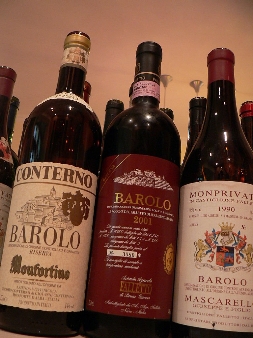
3 瓶 Barolo
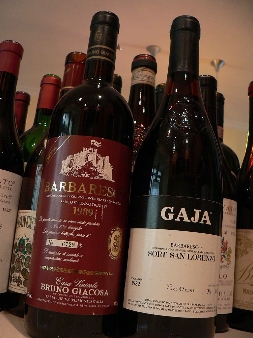
2 瓶 Barbaresco
Giacomo Conterno, Monfortino Riserva
我認為 Monfortino 是最 heroic 的酒,Beethoven 也。
Bruno Giacosa, Barbaresco DOCG Santo Stefano
Bruno Giacosa, Le Rocche del Falletto Riserva, Barolo
我的最愛,我心愛的 Mozart 。
Santo Stefano 是最傳奇性的作品,從 1961 年開始至今快五十年仍然佳作不絕,而且最妙的是葡萄都是別人種的。拿 Giacosa 釀的酒與葡萄農Castello di Neive 自己釀的來比較,總是 Giacosa 的酒好很多。但有意見說 Castello di Neive 近年逐漸把最好的葡萄留給自己,所以 Giacosa 已經沒法用 Santo Stefano 的葡萄造出最好的酒,證據是自 1998 年以來,Giacosa 的 Red label Riserva 都是出自其他葡萄園(Asili 與 Rabaja)。是耶非耶,我尚不能證實。
見﹕Giacosa!
Giuseppe Mascarello, Monprivato, Barolo
最講究 restraint 的酒,這是 Haydn 嗎?
Gaja, Sorì San Lorenzo, Langhe
近世最天才橫溢的 wine producer 。我認為自 Angelo Gaja 出現以後,幾乎所有 Barolo 與 Barbaresco 都可以看到他的影子,雖然沒有人肯承認。見﹕

Brunello di Montalcino 2 瓶
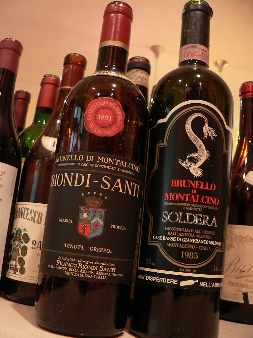
Franco Biondi Santi, Brunello di Montalcino DOCG Riserva
It’s lonely at the top。第一個把 Sangiovese 供奉在神殿最高一層的聖者,肯定前無古人,也幾乎可以肯定後無來者。
我認為這是 Brunello 世界的 Monfortino 。
Case Basse Soldera, Brunello di Montalcino
把 Sangiovese 從天上搬到人間的使者。 All the joys of nature are here!從他的酒幾乎找不到缺點(除了價格)。
如果 Biondi Santi 是 Monfortino , Case Basse 應該是 Santo Stefano !

Sangiovese-based 紅酒 4 瓶
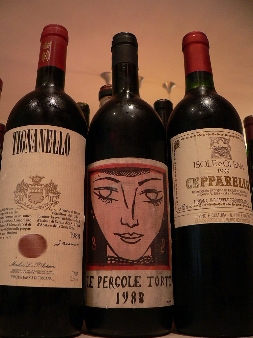
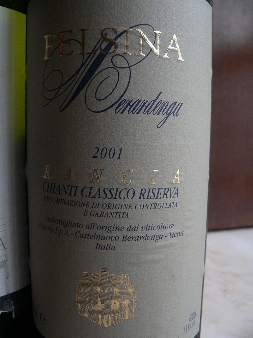
Isole e Olena, Cepparello
Felsina, Rancia Riserva, Chianti Classico
Montevertine, Le Pergole Torte
Sangiovese 在廣大的 Chianti 地區可以幻變出多種面相,保留著Sangiovese 最淳樸的面貌。從整體來說,我認為“Super Sangiovese” 比 Brunello 還要精彩,原因是 Chianti 為Sangiovese 提供了一塊更大的畫布!
三瓶“Super Sangiovese” 當中,南部的 Rancia 厚重,西部的 Cepparello 圓潤,東部高山上的 Le Pergole Torte 飄逸。喜歡那種風格,看你自己的口味。要我選的話,毫無疑問是 Le Pergole Torte 。但三瓶都是貴族酒,平民價。Why wait?
Antinori, Tignanello
意法混血兒,只因 Super Tuscan 的 branding 而大出風頭,但我總覺得他只有名字是意大利的。我不喜歡他的陰陽怪氣,少量的 Cabernet (15-20%)已經壓住了纖細的 Sangiovese 。But who can argue with commercial success?

Bordeaux blend 紅酒1瓶
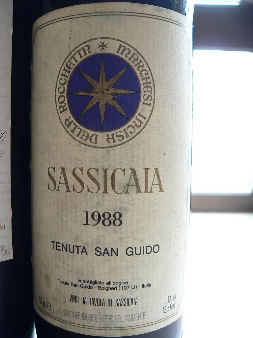
Sassicaia, DOC Sassicaia, Tenuta San Guido
Super Tuscans 的始祖。光是這份功勞,也應該讓他穩佔一席位。有一種貴族氣派,是其他 Super Tuscans 造不出來的,大概歸功于主人的 blue blood ?

Aglianico-based 紅酒1瓶
Mastroberardino, Radici, Taurasi
第一次踫到Mastroberardino Radici 是在紐約一個小餐廳,完全是出于好奇,而且用公司的錢也不想花費太大。我的好友評為「老辣」,我則吃了個大驚﹕竟然有酒比新的 Barolo 還難喝!後來查資料,原來有人稱 Taurasi 為 Barolo of the South 。這令我更好奇了。然後看到 Tom Maresca 這篇文章﹕
http://www.winereviewonline.com/maresca_southernitaly.cfm
文章說 “many knowledgeable wine lovers think that Mastro's 1968 Taurasi Riserva is the best wine produced in Italy in the last century – period.”
對 Tom Maresca 有興趣的,可以再看以下比較新的一篇﹕
我今天仍然在努力找 1968 Riserva 。1968 找不到,但 1997 與 1998 我都曾經喝過。
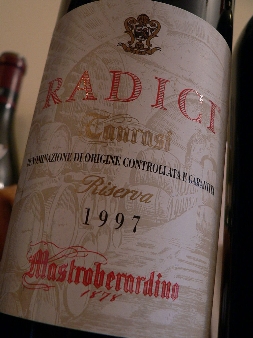
見﹕Taurasi: Barolo of the South?
最近剛找到 1973 !

Amarone 1瓶
Quintarelli, Amarone della Valpolicella Classico
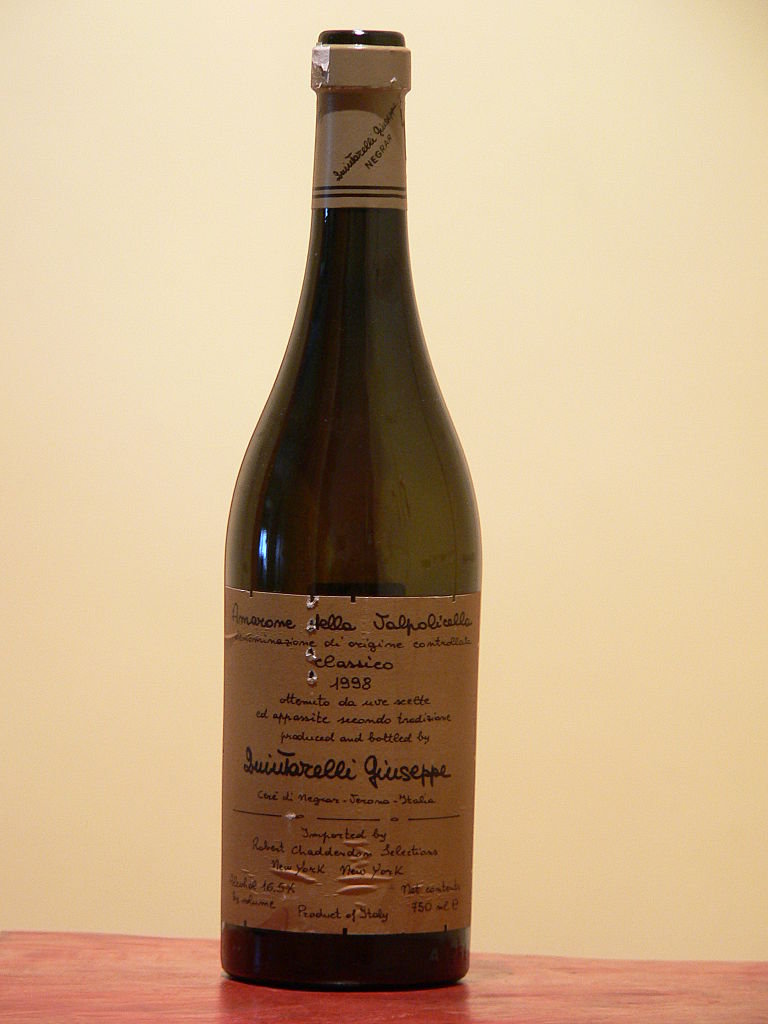
我先後喝過 1998 與 1983,但到目前為止,我還是不懂得欣賞 Amarone 。可能像苦瓜一樣,這需要另外一種美感尺度,但我仍然不能掌握。我聽過一位猶太朋友說他愛 Amarone 是有宗教原因的。他說猶太人春天慶祝逾越節(Passover),以紀念他們在埃及當奴隸的苦難歲月。節慶期間,他們會喝較甜的酒,所以Amarone 很適合。除了這重宗教意義外,也可能因為他年紀大了,想借甜酒思念他甜美的青春歲月!
我想﹕或許等我再老一點吧。

白酒 4 瓶
Gravner, Ribolla Gialla, Friuli-Venezia Giulia
Pieropan, La Rocca, Soave Classico Superiore
Valentini, Trebbiano d'Abruzzo
Jermann Vintage Tunina, Friuli-Venezia Giulia
我對白酒真的外行,但我曾經找過 Gravner 的 Ribolla Gialla 來試,完全是因為我看了這個介紹﹕
http://www.italianwinemerchantstore.com/investing/landmark_wines/gravner_breg_anfora.html
那紅磚色的白酒仍然歷歷在目。蠻有趣的
附錄
Italy's 50 greatest ever wines
Friday 13 June 2008
by Kerin O'Keefe
Source: Decanter http://www.decanter.com/people-and-places/wine-articles/485722/italy-s-50-greatest-ever-wines
Italy is home to myriad wine styles, and the top estates often produce
several different bottlings. So which are the greatest of all Italian wines?
KERIN O’KEEFE canvassed opinion among Decanter’s top Italian experts.
Italy’s free spirit ensures that Tuscany, Piedmont et al are not restricted by the straightjacket of the French-style classification system. Yet most wine lovers have an idea of the names perceived as each region’s top estates. But within these estates, which are the most consistent, and which of their wines are the standout performers? Even more intriguingly, how do these great wines from around the country then compare to one another in terms of their status?
To find the answers, Decanter asked 19 Italian wine experts from four different countries to pick their top five Italian wines of all time, and to stipulate their number one choice. There were no set criteria: wines could be red or white, at any price. Rather than nominating specific vintages, we wanted wines that consistently express all that is great about Italian wine and winemaking. The wines with the most nominations are listed, in order, here.
Unsurprisingly, both Tuscany and Piedmont weighed in heavily among the top picks for the most esteemed reds, with 13 nominations for Tuscany’s most prestigious Brunellos, Chianti Classicos and Supertuscans, followed by 11 illustrious Barolos and Barbarescos from Piedmont. Friuli reigned for its magnificent whites. Prestigious Amarones and pioneering Soaves from Veneto each made the grade, as did a noble Taurasi from Campania and a magnificent Trebbiano d’Abruzzo.
Our dream list underscores the undisputed diversity of the greatest Italian wines and winemaking. Remember, these are not vintage specific – just the greatest wines, year after year.
Giacomo Conterno, Monfortino Riserva, Barolo DOCG
£186 (2000, the latest vintage); F&R
Two years ago, we asked many of our same experts to name the Italian vineyard sites that yield the most outstanding wines. The hands-down winner was Francia in Serralunga d’Alba, the very site where the grapes for our all-time number-one Italian wine are grown. The legendary Barolo Monfortino Riserva made by Giacomo Conterno, now run by the founder’s grandson Roberto, was the clear winner in this poll. Made only in exceptional years, Monfortino is the epitome of everything a great Barolo should be: muscular butrefined; complex and highly seductive. Although many of today’s top Barolo producers embrace both modern and traditional philosophies by using a combination of traditional cask and
French barrique, Giacomo Conterno has always been steadfastly traditional. Roberto has continued the family custom of ageing Monfortino for an average of seven years in large barrels – almost unthinkable today, but necessary to tame the wine’s massive tannins.
Known for its trademark liquorice and mint aromas that complement Nebbiolo’s typical floral notes, Monfortino is powerful yet graceful, and needs lengthy cellaring.
Both Franco Ziliani and Gigi Brozzoni chose Monfortino as their standout wine for its ‘complexity, elegance, harmony and fantastic ageing potential’ (Ziliani),
and ‘because even under such precarious conditions, you can give up everything except elegance’, (Brozzoni).
Sassicaia, DOC Sassicaia, Tenuta San Guido, Bolgheri
£74.58 (1998); C&B
Having heralded the new age of winemaking in Italy, Sassicaia, the experts’ second choice, is the country’s undisputed Renaissance wine. Credited as the original Supertuscan, it was one of the first wines in Italy to be made with Cabernets Sauvignon and Franc, and aged in French barriques. Sassicaia was the brainchild of Marchese Mario Incisa della Rocchetta, who planted Cabernet Sauvignon at his Tenuta San Guido estate in Bolgheri back in 1944 when this strip of Tuscan coast, known as the Maremma, was a malaria-infested backwater with virtually no winemaking tradition. According to Mario’s son Nicolò, who now runs the property: ‘My father was a lover of fine Bordeaux, and decided to try his hand at making wine.
He chose vineyard sites based not only on exposure and altitude, but for their rocky soils, similar to the gravel found in Graves. In Italian, these rocks are called sassi, which is how Sassicaia got its name.’ The original Cabernet Sauvignon planted by Nicolò’s father in the 1940s were cuttings from 50-year-old vines from a friend’s estate near Pisa that has since been pulled up. ‘Many of our vineyards are planted from this clone that has had nearly 100 years to adapt to Tuscany's climate,’ he says. Although Sassicaia was the Marchese’s personal tipple for years, it took until 1968 for his nephew Piero Antinori and Nicolò to convince the aristocrat to release it commercially. It was an instant success among critics thanks to its complex bouquet, breeding and grace. The Marchese then hired wine consultant Giacomo Tachis to further refine it, and increased production by planting other vineyards on the estate, similar to Sassicaia.
Franco Biondi Santi, Brunello di Montalcino DOCG Riserva
£60.87 (2001); ICa, Lui
Franco Biondi Santi’s Brunello riservas are among the most coveted and expensive bottlings in Italy. While these traditionally styled Brunellos may have fallen out of fashion among many wine critics who, until recently favoured fruit-forward, oakdriven wines, loyal fans of extreme elegance have never stopped clamouring for their share of the 15,000 bottles of Biondi Santi Riserva that are produced only in top vintages. Many critics are now showing a renewed interest in this more austere style, as demonstrated by Biondi Santi’s third-place showing in our poll and recent tre bicchieri award from Italian wine guide Gambero Rosso. Biondi Santi, the grand old gentleman of Italian wine, passionately defends the typicity of his Brunello, on which he showers almost filial attention. His grandfather Ferruccio, a gentleman farmer who isolated a particular clone of Sangiovese at his Greppo estate that he vinified separately and aged in wood, is recognised as having invented Brunello back in the late 1800s. Several bottles of his fabled 1888 and 1891 vintages remain in Biondi Santi’s heavily locked wine library, while vintages from Franco’s father Tancredi, one of the greatest Italian winemakers of all time, include the 1955 and 1964 riservas, true monuments to Sangiovese. Franco Biondi Santi’s own bottlings, including the exquisite and complex 1975, are just coming into their own and are extraordinarily youthful.
In keeping with family tradition, Biondi Santi refuses winemaking practices that would change the character of his wine. He ages his Brunellos in large Slavonian oak casks, shuns selected yeasts, and only makes riservas from vines at least 25 years old.
Quintarelli, Amarone della Valpolicella Classico DOCG
£138.65 (1998); Bib
Giuseppe Quintarelli’s limited production Amarone is one of Italy’s most soughtafter wines, even if the family firm has never done any marketing or promotion. It doesn’t have to – word of mouth has elevated the wine to cult status. Made from virtually the same techniques that were passed down from father and grandfather, this legendary Amarone is fermented with indigenous yeasts, aged for eight years in Slavonian casks followed by a year in bottle before release. The resulting wine is big and bold, with mouthfuls of lush fruit.
Bruno Giacosa, Barbaresco DOCG Santo Stefano, Piedmont
£70 IB (2004); Arm
Dubbed the ‘genius of Neive’, Bruno Giacosa is renowned for his extraordinary palate and his unsurpassed knowledge of the Langhe’s best vineyards. One of Giacosa’s greatest wines, Barbaresco from the Santo Stefano cru has the power, depth and complexity usually only found in the greatest Barolos thanks to the vineyard’s perfect southern exposure and limestone/clay soils, and to Giacosa’s celebrated gift for winemaking. According to Isao Miyajima, the wine is ‘complex, enveloping and authentic with incredibly refined tannins… it is a great expression of a great vineyard.’
Bruno Giacosa, Le Rocche del Falletto Riserva, Barolo DOCG
£73.33 IB (2003); Arm
Although Bruno Giacosa has sourced grapes from an exclusive network of growers in select areas for decades, in 1982 he also bought Falletto, one of the most coveted vineyards in the Langhe. ‘Falletto’s limestone soil gives the wine great structure, while the south/southwest exposure allows grapes to ripen under the best conditions, generating a long growing season,’ says the winemaker. ‘Nebbiolo needs to mature slowly to give the wine its complexity.’ In excellent vintages, Giacosa makes one of the most prized Barolos, Le Rocche del Falletto Riserva, from the single vineyard located in the heart of Serralunga d’Alba. A wine of great structure, the Falletto Riserva also has Giacosa’s hallmark of elegance and though enjoyable young, it can easily age for 30–40 years.
Isole e Olena, Cepparello, Tuscany IGT
£34.95 (2003); ACh, P&S, Smp, WFM
In 1976, when Paolo de Marchi, Piedmontese by birth, took over the family’s Isole e Olena property in Tuscany’s Barberino Val d’Elsa, he came with a wealth of experience despite his youth. He immediately went to work on improving the estate’s Chianti Classico by planting select clones of Sangiovese, and in 1980, his admiration for this difficult grape led him to create Cepparello. Made from 100% Sangiovese, Cepparello was part of the breakaway vino da tavola pack whose stellar qualities easily outshone the languishing Chiantis of the period. This is Rosemary George MW’s top pick: ‘It encapsulates the true flavours of Tuscany’.
Giuseppe Mascarello, Monprivato, Barolo DOCG
£38.25 IB (2004); F&R
Of all the great Barolo vineyards, few can boast the prestige of Monprivato, located in Castiglione Falletto, in the heart of Barolo. Renato Ratti, who mapped out the denomination’s prime vineyards in 1985, included Monprivato in his classification of ‘first category’ sites. Though the Mascarello family has owned part of the vineyard since 1904, it wasn’t until 1970 that Mauro Mascarello decided to vinify the grapes from Monprivato separately, and the singlevineyard bottling is only produced in excellent years.
Although he experimented with varied vinification and oak-ageing methods, Mascarello maintains a traditional approach to winemaking. Graceful and exquisite, Monprivato has a delicate ruby-garnet hue and complex bouquet of roses, cherry and smoke, with round fruit flavours that are layered with a hints of liquorice and tobacco that are impeccably balanced with an abundance of silky-smooth tannins.
Case Basse Soldera, Brunello di Montalcino DOCG
£114.75 IB (1999); F&R
Visitors tasting at Case Basse immediately learn the house rules from outspoken
proprietor Gianfranco Soldera, a former insurance broker from Milan. ‘Here at Case Basse, you are only allowed to spit out bad wine. So you do not spit Case Basse.’ Fortunately, you don’t want to. His luminous, delicately hued and ethereal Brunellos are a cult favourite. The greatness of Soldera’s wines begin, he says, with meticulous care in the vineyard. As well as ruthless grape selection, he has generated his own eco-system by creating havens for insects and birds who feed off parasites, allowing him to avoid using pesticides. The wine is an exceptionally elegant expression of Sangiovese with rich fruit and floral notes.
Felsina, Rancia Riserva, Chianti Classico DOCG
£31.49 (2004); Lib, P&S
In 1982, shortly after Giuseppe Mazzocolin left teaching to run his father-in-law’s Felsina estate in Castelnuovo Berardenga, he hired consultant winemaker Franco Bernabei, in a bid to improve the quality of the wine. A year later, Mazzocolin decided to make a Chianti Classico riserva entirely with Sangiovese from the estate’s Rancia vineyards. Grapes ripen perfectly there because there are no hills or trees in front of the vineyards, situated at 410m, to block healthy ventilation. Research has shown that the grapes from the vineyard, which has a complex combination of rocky calcareous soils along with sand and clay, are particular Sangiovese clones unique to Rancia. Concentrated, with aromas of crushed cherry, tobacco and intense floral notes, Rancia combines power and grace.
Gaja, Sorì San Lorenzo, Langhe DOC
£66.25 IB (2003); Arm
Flamboyant and charismatic, Angelo Gaja helped trigger Italy’s quality wine revolution and pushed Barbaresco to the forefront of the country’s wine scene. After taking control of the winery in 1961, Gaja began updating the cellar techniques and in 1967, when blending grapes from different vineyards was the status quo, he vinified grapes from his San Lorenzo vineyard separately. It was his first single-vineyard bottling, and upon its release in 1970, it caused both a national and international sensation, sending Barbaresco prices soaring. Soon, estates all over the Langhe were turning out single-vineyard offerings. Powerful and sleek with refined tannins and great cellaring potential, Sorì San Lorenzo was originally a Barbaresco. But starting with the 1996 vintage, Gaja pulled his single-vineyard bottlings from the Barbaresco DOCG because he felt they overshadowed the firm’s historic Barbaresco, made with grapes from multiple vineyards. It is now a Langhe Nebbiolo DOC, and Gaja adds 5% Barbera for freshness.
Gravner, Ribolla Gialla, Friuli-Venezia Giulia IGT
£29.50 (2000); Adv
This New Age white classic is made by some of the most ancient winemaking techniques in the world. Josko Gravner, one of Italy’s most philosophical and creative winemakers, was one of the first in Friuli to use wood for vinifying and ageing his whites and reds. His cellar practices add depth and body to normally racy whites and were soon imitated the length of Italy. Some years ago, Gravner began experimenting with other techniques, and he now ferments 100% Ribolla Gialla in giant terracotta amphorae from Georgia. He shuns selected yeasts and his winemaking calendar carefully followsthe cycle of the moon. Rich, complex and voluptuous, his Ribolla Gialla has proven even to sceptics the potential of this niche grape variety.
Pieropan, La Rocca, Soave Classico Superiore DOC
£19.95 (2005); Har, HvN, Lai, ScC, WFM
There is Soave, and then there is Soave La Rocca, Pieropan’s pioneering singlevineyard bottling made from 100% Garganega. According to Andrea Pieropan, the secret to its lush but refined version of the local classic is a combination of both soil and strict vineyard management. ‘La Rocca’s vineyard has limestone and clay soils, unusual in Soave, that give the wine its body and exotic fruitiness. To maximise ripening, grapes are late harvested – picking begins towards the end of October,’ says Pieropan. Seeing such grapes still on the vine in November, many hungry wine tourists in Soave had begun to assume they could help themselves to the prized offerings, and the family has had to fence off its famed vineyard to ensure that production levels remain unaffected.
Mastroberardino, Radici, Taurasi DOCG
£17.86 (2003); PlG, Wmb
The name Mastroberardino is synonymous with Taurasi, and for years, this legendary family firm was the only ray of light in the otherwise dismal Campanian wine scene. Often called the Barolo of the South thanks to its massive structure, complexity and marathon ageing capacity, Mastroberardino’s Taurasi Radici is made exclusively from the ancient Aglianico grape. The wine comes from a selection of grapes from top vineyards, and both modern and traditional methods are used in vineyard and cellar. It boasts earthy, smoky and floral aromas, and its rich yet restrained fruit flavours are impeccably balanced by firm tannins and notable acidity. Although approachable when young, a recent tasting of a series of older Mastroberardino Taurasi back to 1934 at the firm’s cellars proved that their ageing potential can surpass even the most famous Barolos.
Montevertine, Le Pergole Torte, Tuscany IGT
£59.99 (2004); DBy, Evy
After the late Sergio Manetti bought the Montervertine estate in Radda in Chianti as a vacation retreat in 1967, he quickly fell in love with winemaking and sold his steel business to devote his boundless energy to Tuscany’s native grapes, notably Sangiovese. In 1977, with the help of Giulio Gambelli, known in Italy as the ‘master taster’ and who still consults for the firm, Manetti created Le Pergole Torte. Though it was an immediate success, it did not conform to the once-uninspiring standards set for Chianti Classico, and was initially labelled as table wine, and later IGT. Today, Sergio’s son Martino continues his father’s tradition of excellence. Elegant and vibrant, the wine beautifully expresses Sangiovese’s floral-berry sensations and boasts extraordinary length.
Antinori, Tignanello, Tuscany IGT
£27 (2004); PlG, Sel, Wmb
One of the original Supertuscans, Piero Antinori’s Tignanello is largely credited for the rebirth and transformation of Chianti Classico. Originally a Chianti Classico Riserva, Antinori pulled Tignanello out of the DOC in 1971. ‘Back then, it was mandatory to make Chianti Classico by adding a rather high percentage of white grapes into the blend. The wines had simple structures and were unsuitable for ageing,’ says Antinori. He reduced the percentage of white varieties, and by 1975, was using only red grapes. Because it no longer adhered to Chianti Classico rules, the wine was labelled vino da tavola. Others followed, and soon the best wines in the zone were not Chianti Classico but renegade table wines.
Valentini, Trebbiano d’Abruzzo DOC
£34 (2003); F&R
On their own, neither the Trebbiano grape, Italy’s most diffused and prolific white variety, nor the remote Abruzzo region inthe centre of the country, stir many wine lovers’ imaginations. But put them together, add the name Edoardo Valentini, and lovers of great Italian wine become downright reverent. Valentini’s Trebbiano is deep, rich and vibrant. With age the wine becomes opulent and complex, unheard of from this usually modest grape. The late Edoardo’s son Francesco says: ‘We’re growers more than winemakers. After choosing only the best grapes, the wine takes the most natural course possible in the cellar.’
Jermann Vintage Tunina, Friuli-Venezia Giulia IGT
£39.10 (2005); EnW
Vintage Tunina proved to the world the great potential of Friuli-Venezia Giulia and earned Silvio Jermann the reputation of being one of the country’s most brilliant winemakers. In 1975, when the region was building a reputation for single-varietal whites, Jermann was experimenting with blends, and created a blend of Sauvignon Blanc, Chardonnay, Ribolla Gialla, Malvasia and Picolit. The result is a deep and complex wine, with stunning floral and mineral aromas.
thx 4 sharing
[版主回覆06/21/2010 13:46:00]n joy!
正 , 照單全收 , 日後遂支揾來慢慢嘆
[版主回覆06/21/2010 13:45:00]AM 兄一出馬,恐怕酒價會快速上升!
當中只試過一部份, 苦工還是要多下一點
[版主回覆06/21/2010 14:00:00]祝你好運!
紅酒中Montevertine, Le Pergole Torte沒喝過,台灣似乎也買不到,Quintarelli, Amarone della Valpolicella Classico有買,但還沒喝過…很喜歡他們家的Valpolicella。白酒則全部沒試過XD…Valentini已成絕響?這份名單似乎較偏重傳統派,但只選18瓶仍是太少了點…
gwaihir
[版主回覆06/23/2010 15:42:00]Montevertine 的 Le Pergole Torte 絕對不可錯過。我覺得酒有幾分像 Soldera!很巧的是,Giulio Gambelli 同時擔當兩家酒莊的 master taster 。
Valentini 的紅酒 Montepulciano d'Abruzzo 我喝過,不簡單!
wow……… good sharing ………thanks……. becos of AM, i started to drink Italian wine………..haha………. i love you use those great composer as a remark…….very nice
[版主回覆06/24/2010 09:16:00]Glad you like the musical analogies. Each bottle of wine made by a winemaker is like a new interpretation of a musical work. Perhaps not all of them are great, but each has character.
I just got a btl of LISINI RISERVA 1975 may i have the opinion from you ?
[版主回覆06/26/2010 13:34:00]Great estate and great vintage. I hope you have a good bottle and would love to hear how it goes. Good luck!
一直很喜歡看你的意大利酒評,但由於我既認識太淺,酒名又難記,一直覺得有點難跟上,這篇終於結構性地把各篇貫穿起來,一個字,正
[版主回覆06/30/2010 15:05:00]客氣了,我也是初哥,我寫的都是我初學過程中的「讀酒報告」,很高興對你有幫助。
嗯~!每瓶都喝過,謝謝。